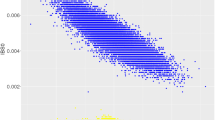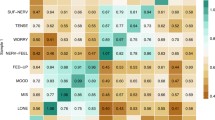Abstract
We examine the hypothesis that environmental transmission is a significant factor in individual differences for Neuroticism among 45,850 members of extended twin kinships from Australia (N = 20,945) and the United States (N = 24,905). To this large data set we fitted a model estimating genetic and environmental components of variance and gene-environmental covariance to examine the causes of individual differences in Neuroticism. For the combined sample we reject models including environmental transmission, shared environment, and a special twin environment in favor of more parsimonious genetic models. The best-fitting model involved only modest assortative mating, nonshared environment, and both additive and nonadditive genetic components. We conclude, first, that there is no evidence for environmental transmission as a contribution to individual differences in Neuroticism in these replicated samples, drawn from different continents, and, second, that a simple genetic structure underlies familial resemblance for the personality trait of Neuroticism. It is interesting that, despite the opportunity provided by the elaborate design and extensive power of our study, the picture revealed for the causes of individual differences in Neuroticism is little more complex than that found from earlier, simpler designs applied to smaller samples. However, this simplicity could not have been confirmed without using a highly informative design and a very large sample.
Similar content being viewed by others
REFERENCES
Akaike, H. (1987). Factor analysis and AIC. Psychometrika 52: 317-332.
Andrews, G. (1996). Comorbidity and the general neurotic syndrome. Br. J. Psychiatry 168 (Suppl. 30):76-84.
Boomsma, D. I. (1996). Using multivariate genetic modeling to detect pleiotropic quantitative trait loci. Behav. Genet. 26:161-166.
Bouchard, T. J., Lykken, D. T., McGue, M., Segal, N. L., and Tellegen, A. (1990). Sources of human psychological differences: The Minnesota study of twins reared apart. Science 250: 223-228.
Digman, J. M. (1994). Historical antecedents of the five-factor model. In Costa, P. T. J., and Widiger, T. A. (eds.), Personality Disorders and the Five-Factor Model of Personality, American Psychological Association, Washington, DC, pp. 13-18.
Eaves, L. J., and Meyer, J. M. (1994). Locating human quantitative trait loci: Guidelines for the selection of sibling pairs for genotyping. Behav. Genet. 24:443-455.
Eaves, L. J., Last, K. A., Martin, N. G., and Jinks, J. L. (1977). A progressive approach to non-additivity and genotype-environmental covariance in the analysis of human differences. Br. J. Math. Stat. Psychol. 30:1-42.
Eaves, L. J., Last, K. A., Young, P. A., and Martin, N. G. (1978). Model-fitting approaches to the analysis of human behaviour. Heredity 41:249-320.
Eaves, L. J., Eysenck, H. J., and Martin, N. G. (1989a). Genes, Culture and Personality: An Empirical Approach, Academic Press, London.
Eaves, L. J., Fulker, D. W., and Heath, A. C. (1989b). The effects of social homogamy and cultural inheritance on the covariances of twins and their parents: A LISREL model. Behav. Genet. 19: 113-122.
Eysenck, H. J., and Eysenck, M. W. (1985). Personality and Individual Differences-A Natural Science Approach, Plenum Press, New York.
Eysenck, S. B. G., Eysenck, H. J., and Barrett, P. (1985). A revised version of the psychoticism scale. Pers. Individ. Diff. 6:21-29.
Finkel, D., and McGue, M. (1997). Sex differences and nonadditivity in heritability of Multidimensional Personality Questionnaire scales. J. Pers. Soc. Psychol. 72:929-938.
Fisher, R. A. (1921). On the 'probable error' of a coefficient of correlation deduced from a small sample. Metron 1:3-32.
Floderus-Myrhed, B., Pedersen, N. L., and Rasmuson, I. (1980). Assessment of heritability for personality, based on a short-form of the Eysenck Personality Inventory: A study of 12,898 twin pairs. Behav. Genet. 10:153-162.
Harkness, A. R., Tellegen, A., and Waller, N. G. (1995). Differential convergence of self-report and informant data for Multidimensional Personality Questionnaire trait: Implications for the construct of negative emotionality. J. Pers. Assess. 64: 185-204.
Heath, A. C., and Eaves, L. J. (1985). Resolving the effects of phenotype and social background on mate selection. Behav. Genet. 15:45-90.
Heath, A. C., Kendler, K. S., Eaves, L. J., and Markell, D. (1985). The resolution of cultural and biological inheritance. Informativeness of different relationships. Behav. Genet. 15:439-465.
Heath, A. C., Neale, M. C., Kessler, R. C., Eaves, L. J., and Kendler, K. S. (1992). Evidence for genetic influences on personality from self-reports and informant ratings.J. Pers. Soc. Psychol. 63:85-96.
Heath, A. C., Cloninger, C. R., and Martin, N. G. (1994). Testing a model for the genetic structure of personality: A comparison of the personality systems of Cloninger and Eysenck. J. Pers. Soc. Psychol. 66:762-775.
Jardine, R., Martin, N. G., and Henderson, A. S. (1984). Genetic covariation between neuroticism and the symptoms of anxiety and depression. Genet. Epidemiol. 1:89-107.
Kendler, K. S., Kessler, R. C., Neale, M. C., Heath, A. C., and Eaves, L. J. (1993a). The prediction of major depression in women: Toward an integrated etiologic model. Am. J. Psychiatry 150: 1139-1148.
Kendler, K. S., Neale, M. C., Kessler, R. C., Heath, A. C., and Eaves, L. J. (1993b). A longitudinal twin study of personality and major depression in women. Arch. Gen. Psychiatry 50:853-862.
Little, R. J. A., and Rubin, D. B. (1987). Statistical Analysis with Missing Data, John Wiley and Sons, New York.
Loehlin, J. C. (1992). Genes and Environment in Personality Development, Sage, Newbury Park, CA.
Loehlin, J. C., Horn, J. M., and Willerman, L. (1981). Personality resemblances in adoptive families. Behav. Genet. 11:309-330.
Loehlin, J. C., Willerman, L., and Horn, J. M. (1985). Personality resemblance in adoptive families when the children are lateadolescent or adult. J. Pers. Soc. Psychol. 48:376-392.
Maes, H. H. M., Neale, M. C., and Eaves, L. J. (1997). Genetic and environmental factors in relative body weight and human adiposity. Behav. Genet. 27:325-351.
Martin, N. G., and Jardine, R. (1986). Eysenck's contributions to behaviour genetics. In Modgil, S., and Modgil, C. (eds.), Hans Eysenck: Consensus and Controversy, Falmer Press, Barcombe, pp. 13-47.
Martin, N. G., Eaves, L. J., Kearsey, M. J., and Davis, P. (1978). The power of the classical twin study. Heredity 40:97-116.
McCrae, R. R., and John, O. P. (1992). An introduction to the fivefactor model and its applications. J. Pers. 60:175-215.
Muthén, B. O., Kaplan, D., and Hollis, M. (1987). On structural equation modeling with data that are not missing completely at random. Psychometrika 52:431-462.
Neale, M. C. (1997). Mx: Statistical Modeling, 4th ed., Department of Psychiatry, Medical College of Virginia, Box 710 MCV, Richmond.
Neale, M. C., and Eaves, L. J. (1993). Estimating and controlling for the effects of volunteer bias with pairs of relatives. Behav. Genet. 23:271-277.
Neale, M. C., and Miller, M. B. (1997). The use of likelihood-based confidence intervals in genetic models. Behav. Genet. 27:113-120.
Pedersen, N. L., Plomin, R., McCleam, G. E., and Friberg, L. (1988). Neuroticism, Extraversion and related traits in adult twins reared apart and reared together. J. Pers. Soc. Psychol. 55:950-957.
Plomin, R., and Daniels, D. (1987). Why are children in the same family so different from one another? Behav. Brain Sci. 10:1-16.
Risch, N., and Zhang, H. (1995). Extreme discordant sib pairs for mapping quantitative trait loci in humans. Science 268:1584-1589.
Rose, R. J., Koskenvuo, M., Kaprio, J., Sarna, S., and Langinvainio, H. (1988). Shared genes, shared experiences, and similarity of personality: Data from 14,288 adult Finnish co-twins. J. Pers. Soc. Psychol. 54:161-171.
Scarr, S., Webber, P. L., Weinberg, R. A., and Wittig, M. A. (1981). Personality resemblance among adolescents and their parents in biologically related and adoptive families. J. Pers. Soc. Psychol. 40:885-898.
Shields, J. (1962). Monozygotic Twins: Brought Up Apart and Brought Together, Oxford University Press, London.
Snedecor, G. W., and Cochran, W. G. (1989). Statistical Methods, 8th ed., Iowa State University Press, Ames.
Tellegen, A., Lykken, D. T., Bouchard, T. J., Wilcox, K. J., Segal, N. L., and Rich, S. (1988). Personality similarity in twins reared apart and together. J. Pers. Soc. Psychol. 54:1031-1039.
Truett, K. R., Eaves, L. J., Walters, E. E., Heath, A. C., Hewitt, J. K., Meyer, J. M., Silberg, J., Neale, M. C., Martin, N. G., and Kendler, K. S. (1994). A model for analysis of family resemblance in extended kinships of twins. Behav. Genet. 24:35-49.
Viken, R. J., Rose, R. J., Kaprio, J., and Koskenvuo, M. (1994). A developmental genetic analysis of adult personality: Extraversion and Neuroticism from 18 to 59 years of age. J. Pers. Soc. Psychol. 66:722-730.
Watson, D., Clark, L. A., and Harkness, A. R. (1994). Structures of personality and their relevance to psychopathology. J. Abnorm. Psychol. 103:18-31.
Author information
Authors and Affiliations
Rights and permissions
About this article
Cite this article
Lake, R.I.E., Eaves, L.J., Maes, H.H.M. et al. Further Evidence Against the Environmental Transmission of Individual Differences in Neuroticism from a Collaborative Study of 45,850 Twins and Relatives on Two Continents. Behav Genet 30, 223–233 (2000). https://doi.org/10.1023/A:1001918408984
Issue Date:
DOI: https://doi.org/10.1023/A:1001918408984




